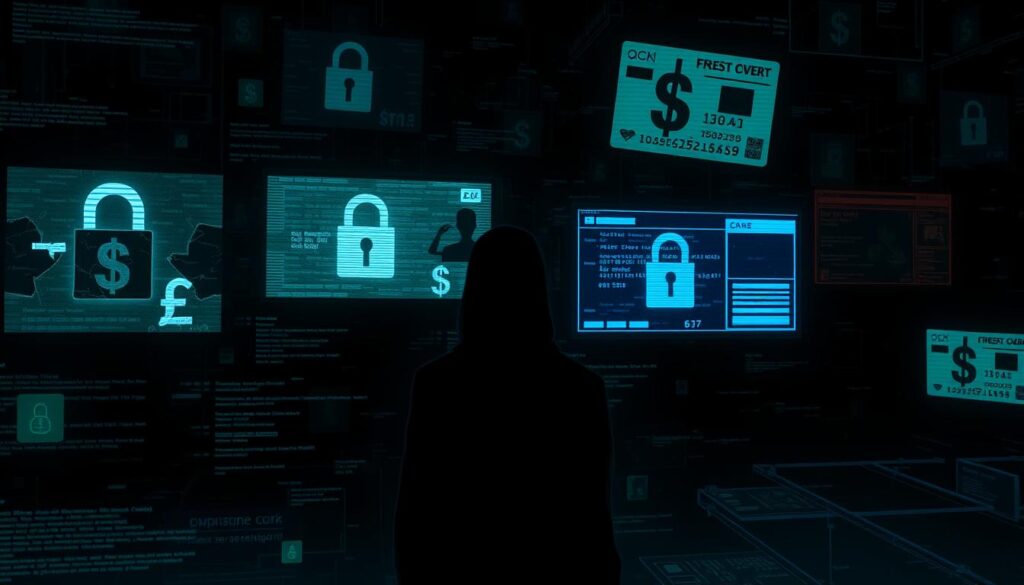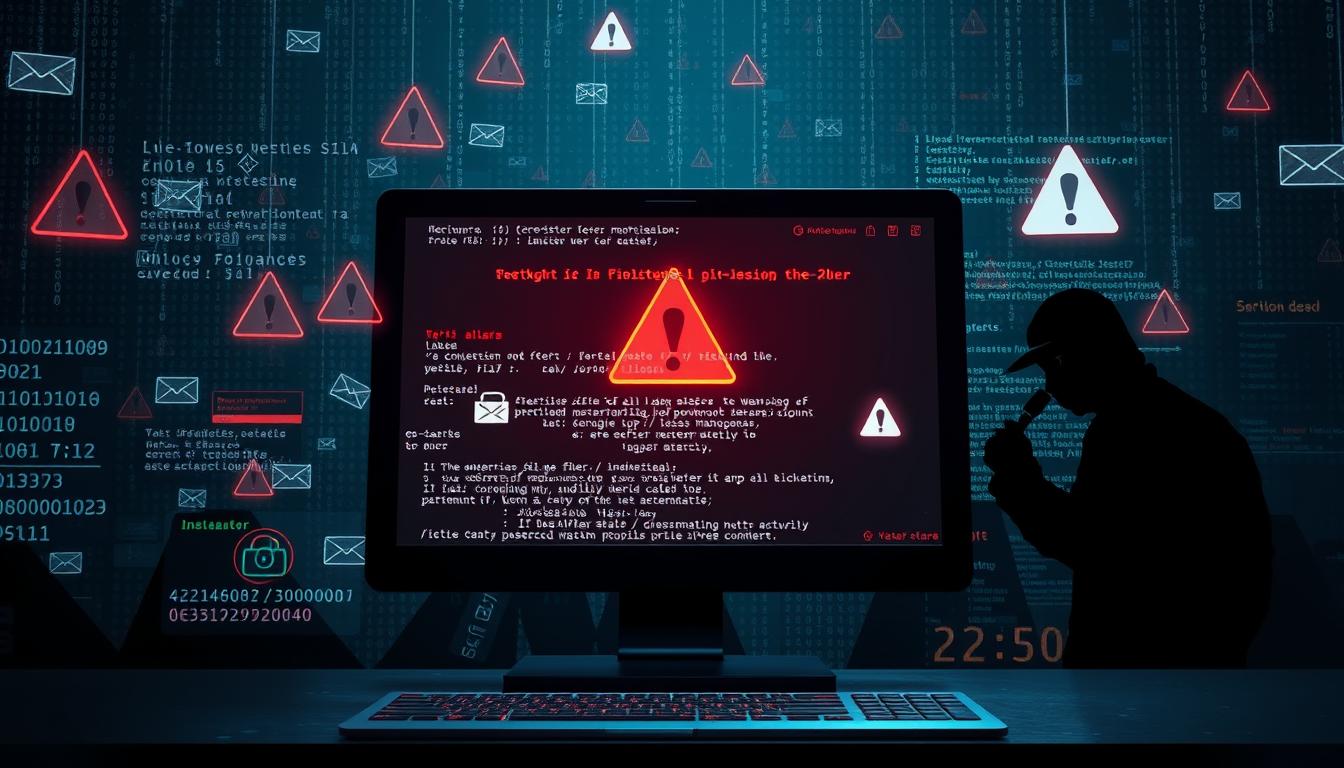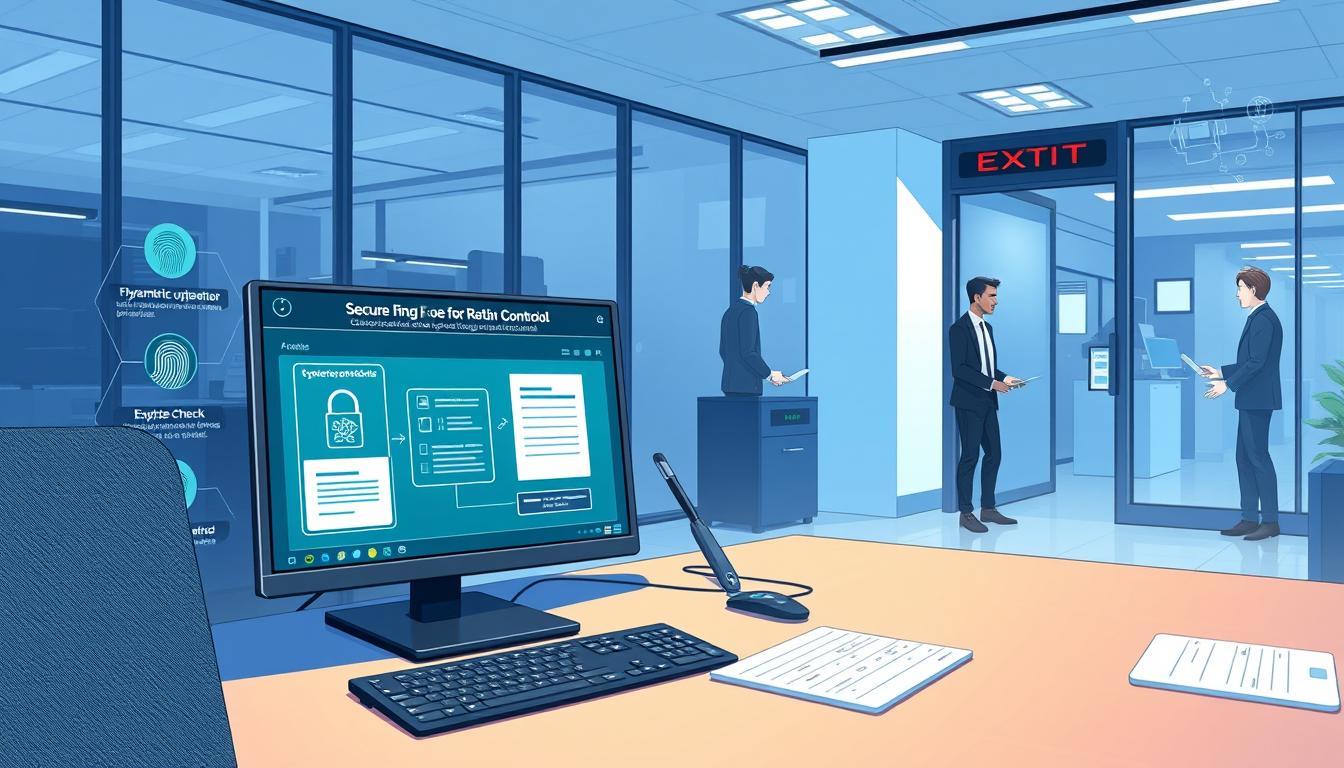Cyberattacks are inevitable, with nearly 100% of organizations facing them at some point1. Most breaches happen because of weak or stolen passwords. This is why strong passwords and two-factor authentication are so important. Knowing the signs of a breach is key to protecting your data and reputation.
Experts say there are many ways to stay safe online. Being alert to security breaches is a big part of it. For example, using two-factor authentication can block unauthorized access even if hackers get your password1. Also, beware of public charging stations, as they can be hacked, putting your device at risk1.
Key Takeaways
- Being aware of the signs of a security breach is key to acting fast
- Understanding breach indicators can help prevent or lessen damage
- Strong passwords and two-factor authentication are vital in stopping breaches
- Keep an eye on your email and account logs for signs of breaches
- Strong cybersecurity and compliance can lower fines in case of a breach
Common Red Flags of a Security Breach
Spotting a data breach can be tough, but knowing the signs helps. It’s key to know how to tell if you’ve been hacked. In 2024, nearly 1.25 billion people had their personal info exposed due to cyberattacks2. This shows why staying alert and proactive is so important.
Look out for unexpected pop-ups and browser redirects. They might mean malware is at work. Also, if your system slows down for no reason, it could be a breach. And if your social media acts strangely, it’s a warning sign too. Spotting these signs early can help prevent damage.
Cybercrime is a big problem, causing billions of dollars in losses every year3. Malware can slow down your devices, affecting both personal and business use3. To fight this, having a solid cybersecurity plan is vital. This includes keeping software up to date, using strong passwords, and teaching employees about online safety.
To learn more about avoiding cyber threats, check out this link on phishing scams. Being proactive and protecting yourself can greatly reduce your risk of being hacked.
- Unexpected pop-ups and browser redirects
- Unusual system slowdowns
- Strange social media activity
- Unauthorized transactions or missing funds
By watching for these signs and protecting yourself, you can avoid security breaches. This keeps your personal and financial info safe.
Unauthorized Account Activity and Access Patterns
In today’s digital world, spotting a breach is key. Warning signs of a cyberattack can be small but very harmful. Studies show that unauthorized people can get to personal data, like names and social security numbers. This can hurt over 60% of companies involved in data breaches4.
It’s important to watch account activity and access patterns for signs of a breach. This helps protect sensitive data.
Up to 90% of organizations face unauthorized access in data breaches4. This is a big risk to our data. To fight this, we need strong security steps like 2-factor authentication and checking logs often. Knowing these signs helps us act fast to stay safe from cyber threats.
Also, cybersecurity experts say to be careful with public computers and watch out for suspicious emails or phishing. These can mean a breach is happening5. By being careful and alert, we can lower the risk of a breach and keep our data safe.
Training employees and using many cybersecurity steps can really help. Companies with multi-factor authentication see 99.9% fewer account takeovers5. By focusing on cybersecurity and being proactive, we can make the digital world safer and more secure.
Technical Signs You’ve Been Breached
It’s key to spot signs of a compromised system to stop and lessen cyber breaches. Cyber breach signs can be hard to see, but knowing them helps a lot. For example, odd network traffic, like strange data access, might mean a breach6. Also, changed system files or odd process activity hint at a breach6.
Some common signs of a security breach include:
- Suspicious network traffic, like access at odd hours or from places not usual for the user6
- Modified system files, which could mean malware6
- Unusual process activity, like unexpected software installs or browser changes7
- Disabled security tools, making a system open to attacks8
Knowing these signs and acting fast is vital to protect yourself and your business from cyber threats. Spotting these signs early can help stop or lessen breach damage. For instance, if you see odd network traffic, check and block further unauthorized access6. If system files are changed, scan for viruses and remove malware7.
Keeping an eye on system activity and knowing breach signs helps you stay ahead of threats. By being proactive, you can lower breach risk and safeguard your data8.
Mobile Device Breach Indicators
Mobile devices are now a big target for cyber threats. Knowing the data breach warning signs helps you act fast to protect yourself and your business. If your mobile shows odd pop-ups or browser changes, it might be hacked9. Also, sudden data usage spikes, without an unlimited plan, could mean a hack9.
Look for signs like fast battery drain, odd data use, and slow performance. Seeing new apps, getting lots of notifications, or being locked out of accounts hints at a breach10. For more on keeping your mobile safe, visit this link.
Some common signs of a mobile breach include:
- Unexplained spikes in data usage
- Unexpected battery drainage
- Unfamiliar apps on your home screen
- Constant notifications
- Being locked out of accounts
Be careful with what you plug into your device. Knowing breach signs helps you prevent or lessen damage9.
By spotting these data breach warning signs and protecting your device, you lower breach risk. Always check app permissions, use strong security software, and avoid public Wi-Fi and charging stations10.
Email and Communication Security Warnings
Being alert to email and communication security warnings is key to spotting a data breach. Look out for odd emails, password reset alerts, and strange login spots. Data shows that 90% of breaches come from phishing, showing how big a threat fake emails are to your email safety11. Also, 81% of breaches use weak or stolen passwords, making strong passwords a must11.
To stay safe from cyber threats, be careful on public computers. Use unique, strong passwords and turn on two-factor authentication (2FA)12. Also, keep an eye on your email’s “Recent Activity” to spot unauthorized logins12. Spotting these signs early can help stop or lessen a security breach’s harm.
Some important email and communication security warnings to watch for include:
- Sent items you didn’t write
- Password reset notifications
- Unusual login locations
These signs mean your email might be at risk. It’s vital to act fast to avoid more harm. By knowing these warning signs and protecting yourself, you can lower the chance of a data breach and keep your email safe.
Financial and Identity Theft Indicators
It’s key to spot warning signs of a cyberattack to avoid financial and identity theft. In 2019, over 14 million Americans fell victim to identity theft13. Being alert to signs like unusual transactions or account activity is vital.
A sudden drop in credit scores can be a sign of identity theft. People should look into any big changes without reason14. Also, watching for hard inquiries on credit reports is important. Unfamiliar inquiries might mean someone’s using your name for credit14. Staying on top of your financial and personal info helps prevent identity theft.
Some common signs of financial and identity theft include:
- Unusual transactions on bank statements
- Changes to credit reports
- Denials of loan applications
Knowing these signs and acting fast can protect you from identity theft. For more on warning signs of identity theft, check out Experian’s website.

It’s critical to recognize cyberattack warning signs and take steps to protect yourself. By staying informed and watchful, you can lower the risk of financial and identity theft1314.
Immediate Steps to Take After Identifying a Breach
Spotting a breach early is key to avoiding more harm. When a breach is found, acting fast is vital. This means isolating the system, keeping evidence safe, and getting expert advice.
Having a solid breach response plan is essential. It should cover isolating systems, saving evidence, and talking to stakeholders. About 83% of companies have faced a data breach, showing how common these issues are15. Good communication can lower customer worry by up to 30%15, making a communications plan critical.
Here are steps to take when facing a breach:
- Isolate the system to prevent further damage
- Preserve evidence to aid in the investigation
- Seek professional help to recover from the breach
The average cost of a data breach in 2023 was $4.45 million, IBM’s report found16. Quick action and a strong breach plan can lessen the impact. This helps avoid more problems and reduces the risk of cyberattacks.
| Step | Description |
|---|---|
| System Isolation | Isolate the system to prevent further damage |
| Evidence Preservation | Preserve evidence to aid in the investigation |
| Professional Help | Seek professional help to recover from the breach |
Conclusion: Building a Stronger Security Posture
It’s vital to know the signs of a breach in today’s digital world. Cybersecurity breach indicators and data breach warning signs are everywhere. By spotting these signs, you can act fast to protect yourself and your business from cyber threats.
Almost 90 percent of data breaches happen because of weak cybersecurity17. The cost of a data breach has gone over $4 million18. This shows we need strong cybersecurity to fight off threats like malware, ransomware, and DDoS attacks17.
More companies are seeing cybersecurity as a big risk. In 2021, 70% of CEOs made cybersecurity a top priority for their boards18. By having incident response teams and doing regular checks, businesses can lower breach costs and boost their security. It’s key to keep watching for breach signs, as healthcare data breach costs jumped from $7.13 million in 2020 to $9.23 million in 202119.
To wrap it up, a strong security posture needs a proactive mindset. It’s about knowing the signs of a breach and acting quickly to protect yourself and your business. By understanding the importance of cybersecurity breach indicators and data breach warning signs, we can prevent or lessen the damage. This way, we can lower the risk of a breach and its costs171819.
FAQ
What are the common signs of a cybersecurity breach?
How can I identify if my account has been breached?
What are the technical signs of a security breach?
How can I protect my mobile device from cyber threats?
What are the email and communication security warnings I should look out for?
How can I identify if I’ve been a victim of financial and identity theft?
What should I do if I identify a breach?
How can I build a stronger security posture?
Source Links
- 52 Cybersecurity Tips for Personal or Business Application You Need in 2019 – https://www.drizgroup.com/driz_group_blog/52-cybersecurity-tips-for-personal-or-business-application-you-need-in-2022
- How To Tell If You’ve Been Hacked: 12 Warning Signs – https://www.aura.com/learn/have-i-been-hacked
- How To Know If You Have Been Hacked: 8 Red Flags To Watch Out For | OneCloud IT Solutions – https://www.onecloud.com.au/resources/how-to-know-if-you-have-been-hacked-8-red-flags-to-watch-out-for/
- Recognizing the Telltale Signs of Data Breaches – Cornerstone Discovery – https://cornerstonediscovery.com/recognizing-the-telltale-signs-of-data-breaches/
- You’ve Probably Already Been Breached: How to Know – Forthright Technology Partners – https://www.forthright.com/youve-probably-already-been-breached-how-to-know/
- Top signs that you’ve been breached – https://www.networkworld.com/article/683632/tech-primers-top-signs-that-you-ve-been-breached.html
- 14 signs of being hacked in 2025 – Surfshark – https://surfshark.com/blog/how-to-know-if-youve-been-hacked
- These Red Flags Could Mean You’ve Been Breached – Total Compliance Tracking – https://www.totalcompliancetracking.com/data-breach-red-flags/
- Hacked Smartphone? Learn the Signs Before It’s Too Late – https://www.geek-aid.com/resources/articles/hacked-smartphone-the-phone-hacked-signs-you-need-to-know.html
- How to Know If Your Phone Has Been Hacked | McAfee Blog – https://www.mcafee.com/blogs/mobile-security/help-i-think-my-phones-been-hacked/
- The Meaning & Telltale Signs of a Compromised Email Account – https://guardiandigital.com/content/compromised-email-account
- Email Hacked? | DataGroup Technologies, Inc – https://dtinetworks.com/cyber-security-tip-4-has-your-email-been-hacked/
- Identity theft | USAGov – https://www.usa.gov/identity-theft
- 25 Warning Signs of Identity Theft: How To Tell If You’re a Victim – https://www.aura.com/learn/signs-of-identity-theft
- Data Breach Response: A Guide for Business – https://www.ftc.gov/business-guidance/resources/data-breach-response-guide-business
- 8 Steps for Data Breach Response and Investigation | Syteca – https://www.syteca.com/en/blog/data-breach-investigation-best-practices
- What is Cybersecurity Posture? Key Steps and Insights – https://www.sentinelone.com/cybersecurity-101/cybersecurity/cybersecurity-posture/
- Secureworks 5 Critical Steps to a More
Mature Security Posture – https://www.secureworks.com/-/media/files/us/white-papers/secureworks_eco_5criticalstepstoamorematuresecurityposture.pdf - Discovering that you have been hacked – https://www.physicianspractice.com/view/discovering-that-you-have-been-hacked







